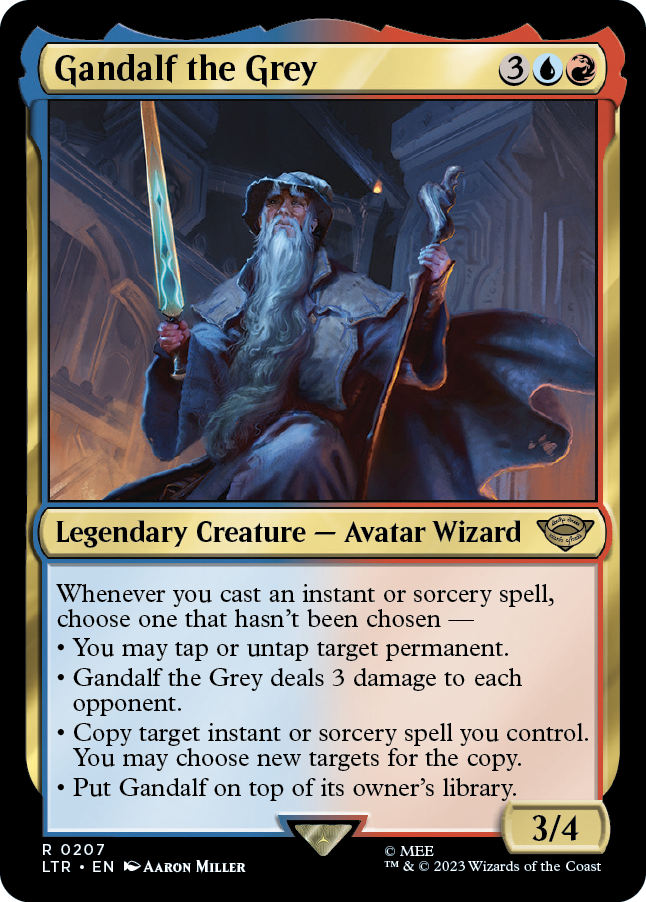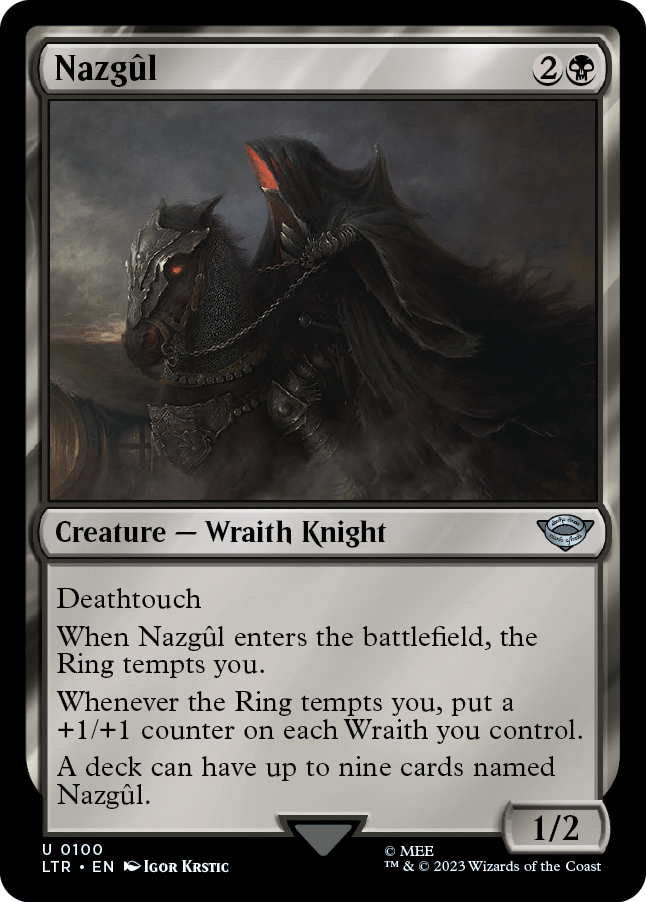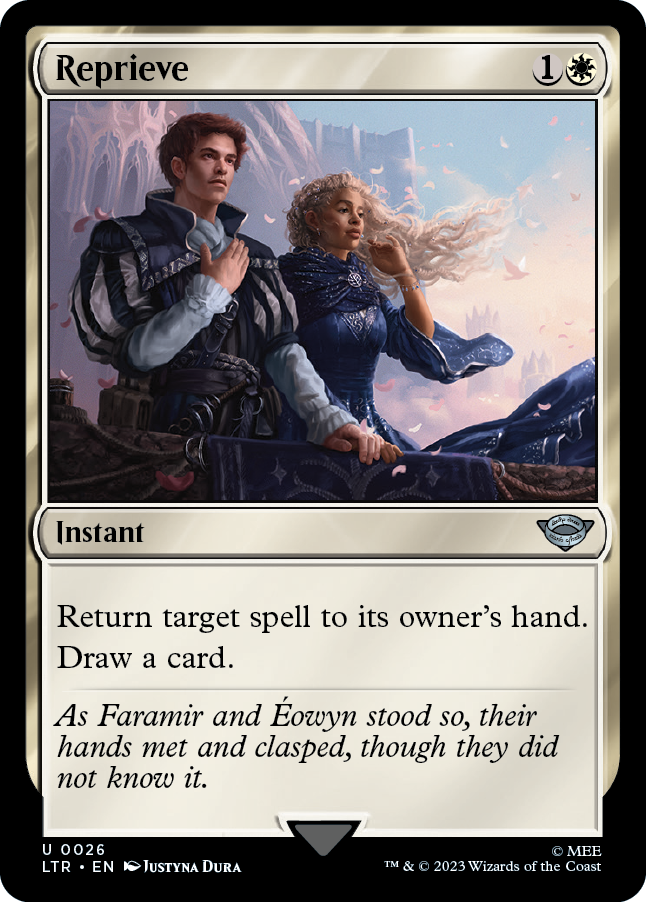Stepping Into the Ring, Part 3
Last month, I started my card-by-card design stories from The Lord of the Rings: Tales of Middle-earth™ (Part 1 and Part 2). Today is the third and final column in this series.
Gandalf the Grey

Gandalf is probably the best-known character from The Lord of the Rings. We knew early that we wanted multiple versions of the character, one of which was Gandalf the Grey, the version of him that joins the Fellowship and begins the journey to Mount Doom. In the Mines of Moria, he would be killed by the Balrog to be resurrected as Gandalf the White (a different card in the set).
There were a couple things the designers wanted to capture with Gandalf the Grey:
- We wanted to show he was a powerful Wizard.
- We wanted a fun card to build around.
- We wanted to hit the story point that he goes away to later return.
Our initial plan was to have two Gandalf cards, a Gandalf the Grey and a Gandalf the White. Along the way, we would decide instead to have three. The one from the beginning of the story would be uncommon, the one from the middle rare, and the one from the end mythic rare. This wasn't known when the card's design began, but the card did begin as a rare.
Gandalf the Grey (version #1)
2UU
Legendary Creature — Avatar Wizard
3/4
At the beginning of your upkeep, choose one that hasn't been chosen. If you can't, draw three cards, then put CARDNAME on top of your library.
• Scry 2.
• Create a 2/2 white and blue Bird creature token with flying.
• Tap up to three target creatures.
Four different times we've done something called "You Make the Card" where we let the audience, through a series of votes and submissions, create a Magic card. For the fourth "You Make the Card," the audience chose to make a black enchantment. The card the public chose was called
Magic Origins was about the history of the five initial Planeswalkers to join the Gatewatch. Liliana, one of the five, is a necromancer who made a deal with four demons. We loved the mechanical execution of getting to choose from a list of four things, one of which lost you the game. You get power, but it comes at a cost, something you have to deal with or lose the game.
This template proved fertile for design. Since
Interestingly, the very first version of the card made use of it, although it didn't template it such that the last choice was one of the modes. I assume this was because they didn't want you drawing the cards right away. The general flavor of Gandalf joining you and leaving afterwards was built into the card from the beginning.
The abilities chosen for Gandalf for version one were just generally useful blue effects, as the first version was mono-blue. I assume the Bird was white and blue as another card was using that token.
Gandalf the Grey (version #2)
2UU
Legendary Creature — Avatar Wizard
3/4
At the beginning of your upkeep, choose one that hasn't been chosen. If you can't, draw three cards, then put CARDNAME on top of your library.
• Choose a creature you control to become your Ring-bearer. (It's legendary and has ward {2}.)
• Create a 3/2 white and blue Bird creature token with flying.
• Tap up to one target creature. It doesn't untap during its controller's next untap step.
Whenever you have a modal card, design will spend a lot of time on the effects. Just changing one ability can have a big impact on gameplay. While I don't show every iteration as the card changes, I tend to pick points in the design where cards have a significant enough shift to be interesting. Design would change one of the effects, play with it, get feedback, then make the next change. That change wouldn't just be with the abilities but would also tweak the mana cost, the power, and the toughness.
This version tested out whether Gandalf should have the Ring mechanic and whether the effects were close enough in power to give players an interesting choice to make. Modal cards where you always pick the same effect first are less interesting.
Gandalf the Grey (version #3)
3UU
Legendary Creature — Avatar Wizard
3/4
Whenever you cast an instant or sorcery spell, choose one that hasn't been chosen —
• Draw two cards, then discard a card.
• Create a 3/2 white and blue Bird creature token with flying.
• Copy that spell. You may choose new targets for the copy.
• Put CARDNAME on top of your library.
We questioned whether we wanted to make the hoop of the effect a little smaller. A creature triggering every turn doesn't require the player to do anything other than keep the creature on the battlefield. It doesn't encourage much deck building. Perhaps Gandalf the Grey would be a more interesting card if it encouraged some type of behavior. Because Gandalf is a wizard who cast spells, casting instants and sorceries felt flavorful. The other advantage to making a smaller hoop is that you can increase the size of the effects.
Drawing three cards proved to be a little too much, so they decided to break it away from the return-to-top-of-library ability. This change let them make that ability one of the modes. Gandalf's draw ability turned into drawing two cards and discarding one, as the average mode is of a smaller power level. Triggering off instants and sorceries also allowed them to make one of the modes copy a spell.
Gandalf the Grey (version #4)
3UU
Legendary Creature — Avatar Wizard
3/4
When CARDNAME enters the battlefield, choose a creature you control to become your Ring-bearer. (It's legendary and has ward {2}.) Whenever one or more legendary creatures you control deal combat damage to a player, draw a card.
When I write these articles, I go to our database and look up the history of the card (and often talk to the set lead designer). Because I was only involved in vision design and not set design, many of the changes happened after I left the team. I was honestly shocked when they moved away from the
A quick aside, there's nothing wrong with trying something different. The old version is saved in the records, and we can always return to it. Sometimes, the best way to see if something is working is to remove it and see what happens when it's gone. Gandalf interacting with the Ring mechanic wasn't working as part of a modal choice, so they changed it.
Gandalf the Grey (version #5)
2U
Legendary Creature — Avatar Wizard
1/3
You may cast sorcery spells as though they had flash.
Instant and sorcery spells you cast during an opponent's turn cost {2} less to cast.
The next change was a big one. For starters, they moved the card from rare to uncommon. Originally, the major characters were all at rare and mythic rare. The biggest playtest note we get is "where are all the characters I know?" When you play The Lord of the Rings: Tales of Middle-earth, you want to play with Gandalf, Frodo, and Aragorn.
This was what made us realize that we needed multiple versions of the main characters. We could aim one at Constructed formats and put it at rare while aiming the other at Limited and putting it at uncommon. Gandalf the Grey was moved to uncommon. (Remember, at this point there are only two Gandalf cards in the file.)
When they moved it, they completely redid the design to reflect the needs of being a Limited card. Gandalf seemed like the best character to have an "instants and sorceries matter” theme, something carried over from the rare version. The two abilities encourage you to cast all your instants and sorceries on your opponent's turn.
Gandalf the Grey (version #6)
2UU
Legendary Creature — Avatar Wizard
3/4
Flash
You may cast sorcery spells as though they had flash.
Other spells you cast during another player's turn can't be countered.
The biggest reaction to the last version was that it was too small. They re-costed the card to make it play better in Limited, but Gandalf being a 1/3 just felt wrong. This version fixed that and tried a different second ability to get your spells through.
Gandalf the Grey (version #7)
3UR
Legendary Creature — Avatar Wizard
4/4
Whenever you cast an instant or sorcery spell, choose one that hasn't been chosen —
• Draw two cards, then discard a card.
• Target creature you control becomes your ringbearer.
• Create a 3/2 white and blue Bird creature token with flying.
• Put CARDNAME on top of your library.
It was at this point that the Set Design team decided they wanted three Gandalf cards: one at uncommon, one at rare, and one at mythic rare. The last version would be the start of the uncommon version. It would keep the first ability but add in a Ring ability. The key was something that encouraged you to give it to creatures other than Gandalf. Gandalf the Grey returned to rare and went back to the
Gandalf the Grey (version #8)
2UR
Legendary Creature — Avatar Wizard
3/4
Whenever you cast an instant or sorcery spell, choose one that hasn't been chosen —
• Add two mana of any one color.
• CARDNAME deals 3 damage to any target.
• Copy an instant or sorcery spell you control. You may choose new targets for the copy.
• Put CARDNAME on top of your library.
From this point forward, the Set Design team was just endlessly tweaking the card. They tried different abilities. For a while, it tapped things, then untapped, then did either. They tried only triggering on the first instant or sorcery you play each turn. They tried different mana values. They tried different power and toughness combinations, interestingly ending up exactly where they started.
When the dust settled, they liked a
Nazgûl

In Alpha, Richard Garfield made a card called
The intent of the card is that you wanted to play a lot of them in your deck since they make each other stronger. Remember, deck construction rules wouldn't officially happen until Wizards started up the DCI in January of 1994. In the super-early days, decks of nothing but
R&D tried numerous times to recapture the feel of Plague Rats, usually choosing to make the creatures bigger based on all your Rats.
Then during Fifth Dawn, we tried a new approach. What if the card just let you include as many copies as you wanted to play? You want to just use Swamps and this card? We won't stop you. Once we had the "a deck may have any number" technology, we used it, although sparingly, on other cards. In the beginning, it was just used in black, although not always on Rats.
Ravnica Allegiance introduced the ability to blue, and Throne of Eldraine and Strixhaven would give it to red. The Council of Colors have talked about this. We've determined that, as long as the card fits into its color, any color can have access to "a deck may have any number" text.
In Throne of Eldraine, I wanted to capture the flavor of the seven dwarves. My original plan was to have exactly seven Dwarf cards in the set, but it took up too much space and was a little too much of a constraint on card concepting. My solution was to make one card called
We used that technology again in The Lord of the Rings: Tales of Middle-earth. We knew we wanted to have Nazgûl. They're one of the big villains in the story, but like the seven dwarves, we didn't have space to do nine. Luckily, we'd solved the problem already. Nazgûl uses the
Reprieve (white counterspell)

The Council of Colors, mentioned above, is a group that oversees the design of all the cards to make sure the color pie is being properly used. (I wrote an article on it here.) It's our job to make sure that cards don't get printed that do something a color shouldn't do. Interestingly, it's also the team's job to make the rest of R&D aware of what effects could be done in colors that aren't currently being done. Whether or not those cards get made is up to the teams creating the cards. The Council of Colors can suggest ideas, and many of us are on various design teams, but we can't get them made if the group doesn't want to make them.
The relevant example is white counterspells. White can do taxing, which means it can have the text "counter target spell unless the opponent [pays a cost]." Now, cost has to be something players can pay the majority of the time because otherwise it just becomes too similar to “counter target spell.” White taxing makes the opponent choose whether to pay the tax, but that means the tax has to be a real option for the player.
In addition, white is allowed to delay things. This means white can have spells that temporarily stop a spell. One way to do this is to return the spell to its owner's hand ( effectively countering it). The owner of the spell can cast it again, so it's more about slowing down the spell being played than permanently removing it as a threat.
These two things—taxing and delaying—are in white's slice of the color pie. They have been for many years. Why, then, are there so few white counterspells in print? Because R&D didn't want to make them. Counterspells are very polarizing, and the thought was that we needed to be careful pushing the ability to a second color. So how did Reprieve get made?
Glenn Jones, the lead set designer for The Lord of the Rings: Tales of Middle-earth, decided it would be a good addition to the set. He was tasked with making cards that would be relevant in Modern, and his research said this would be a good fit. First, he came to the Council of Colors. We told him that "this is in white's pie. It has been forever. We're excited someone's making a card with the effect." He then worked with Set Design and Play Design to clear it. There were a bunch of discussions, but in the end, Glenn was triumphant and the card made it to print.
Ring-ing For All to Hear
We've come to the end of my three-part series. I hope you enjoyed hearing all the tales from the cards of Middle-earth. As always, I'm eager to hear your feedback on today's column, any of the cards I've talked about, or The Lord of the Rings: Tales of Middle-earth. You can email me or contact me through my social media accounts (Twitter, Tumblr, Instagram, and TikTok).
Join me next week on Tuesday as we kick off previews for Commander Masters.
Until then, may your time playing with The Lord of the Rings: Tales of Middle-earth be more Shire and less Mount Doom.

